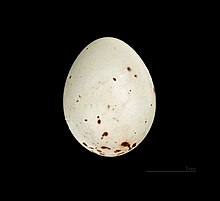Teydefink
| Teydefink | ||||||||||||
|---|---|---|---|---|---|---|---|---|---|---|---|---|

Teide finch ( Fringilla teydea ), male |
||||||||||||
| Systematics | ||||||||||||
|
||||||||||||
| Scientific name | ||||||||||||
| Fringilla teydea | ||||||||||||
| Webb , Berthelot & Moquin-Tandon , 1841 |
The Teydefink ( Fringilla teydea ), also Teidefink , is a songbird belonging to the family of finches (Fringillidae) . It was named after the highest mountain on the island of Tenerife , the stratovolcano Teide , and is the animal symbol of the island of Tenerife.
features
With a length of 16 to 18 centimeters, the Teydefink is visibly larger than the chaffinch . The beak, head and chest are stronger than those of the chaffinch.
The drawing of the plumage is inconspicuous. The wings have two narrow, gray-white bands that are created by the light-colored ends of the middle and large arm covers. The dark tail does not contain white.
The male has a blue-gray head and coat (upper back), the throat, chest and flanks are lighter lead-gray. The under tail-coverts are white. The female has a brown-gray upper side and a gray-white underside.
distribution
The Teydefink is an endemic species of bird of the island of Tenerife. It is considered potentially endangered and has been under protection in the Canary Islands since 1980. The small population on Gran Canaria has traditionally been viewed as the subspecies Fringilla teydea polatzeki . However, recent research from 2016 suggests that this should be outsourced as an independent species, Fringilla polatzeki . The (sub) species is classified as critically endangered due to its rarity.
The Teydefink is the sister species of the chaffinch.
voice
The call is a two-syllable "tjrooit" with a slightly squeaky sound. The singing is shorter and less powerful than the chaffinch and slows down towards the end. It consists of several descending and somewhat rough-sounding tones, the last of which is drawn out. For example "sitt-itt-sitt-rüha-rüha-rrüüAAH".
habitat
The habitat are pine forests. In these the brood takes place at an altitude of 1200 to 1800 meters. The foraging for food also takes place in pine forests, partly on mountain slopes with dense bushes, in hard winters also in cultivated landscapes down to 500 meters.
See also
swell
Individual evidence
- ↑ Ley 7/1991, de 30 de April, de símbolos de la naturaleza para las Islas Canarias
- ↑ Integrative taxonomy reveals Europe's rarest songbird species, the Gran Canaria Blue Chaffinch Fringilla polatzeki. George Sangster, Felipe Rodríguez Godoy, CS Roselaar, Magnus S. Robb and Jolanda A. Luksenburg
- ↑ HD Marshall, AJ Baker: Rates and patterns of mtDNA sequence evolution in Fringilline finches ( Fringilla spp. ) And the Greenfinch ( Carduelis chloris ). In: Mol. Biol. Evol. 15, 1998, pp. 638-646.
literature
- HG Bauer, E. Bezzel, W. Fiedler : The compendium of birds in Central Europe. Passeriformes passerine birds. 2., completely revised Edition. AULA-Verlag, Wiebelsheim 2005, ISBN 3-89104-648-0 .
- L. Svensson, PJ Grant, K. Mullarney, D. Zetterström: The new cosmos bird guide - All species of Europe, North Africa and the Middle East. Franckh-Kosmos Verlag, Stuttgart 1999, ISBN 3-440-07720-9 .
- Christopher M. Perrins (Ed.): The FSVO encyclopedia birds of the world. Translated from the English by Einhard Bezzel. BLV, Munich / Vienna / Zurich 2004, ISBN 978-3-405-16682-3 (Title of the original English edition: The New Encyclopedia Of Birds. Oxford University Press, Oxford 2003).
Web links
- Fringilla teydea in the endangered Red List species the IUCN 2008. Posted by: BirdLife International, 2008. Accessed January 31 of 2009.
- Videos, photos and sound recordings for Fringilla teydea in the Internet Bird Collection
- Feathers of the Teydefink

